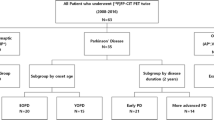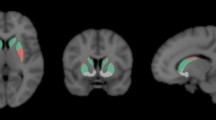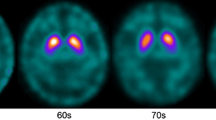Abstract
Objective
Dopamine transporter (DAT) imaging shows age-related decline of ligand binding in the normal striatum, a decline attributed to regulatory changes. We investigated if similar changes occur in the striatum of Parkinson’s disease (PD) patients, using PET and [18F]FP-CIT, a ligand for DAT.
Methods
We performed [18F]FP-CIT PET in 39 drug-naïve, de novo PD patients (age 56.0 ± 11.6 years, mean ± SD) and 34 healthy control subjects (age 52.3 ± 17.8). Parkinsonism was assessed by UPDRS III and Purdue pegboard. Binding ratios of [18F]FP-CIT were obtained in the putamen and caudate using the occipital cortex as reference.
Results
Mean [18F]FP-CIT binding ratios in PD were 3.76 ± 0.74 (mean ± SD) in the putamen and 6.80 ± 1.05 in the caudate nucleus, significantly smaller than those in the healthy control (9.20 ± 1.38, 8.66 ± 1.12, respectively; p < 0.001 vs. healthy control for both). Regression analysis of [18F]FP-CIT binding ratios on age in healthy subjects showed significant correlations in the putamen (p < 0.001) and caudate nucleus (p < 0.001). Similar analysis in PD patients also showed significant correlations in the putamen (p = 0.015) and caudate nucleus (p = 0.018). The slope of regression in the putamen was −0.061 in the healthy control and −0.017 in PD, with significant differences between the two groups (p = 0.0003). In contrast, the regression slope in the caudate nucleus was −0.040 in the healthy control group, and −0.032 in the PD group with no significant differences between the two groups.
Conclusions
Striatal [18F]FP-CIT binding showed significant age affects in patients with de novo PD after standardization for the severity of disease. The age effects were significantly smaller in PD patients than those in healthy subjects, but only in the putamen, not in the caudate nucleus. Given that age-related attrition of DA neurons is even in normal striatum, the uneven age effects in the parkinsonian striatum are likely to reflect the superimposition of disease-driven compensation on the aging effect.


Similar content being viewed by others
References
Martin WR, Palmer MR, Patlak CS, Calne DB. Nigrostriatal function in humans studied with positron emission tomography. Ann Neurol. 1989;26:535–42.
van Dyck CH, Seibyl JP, Malison RT, Laruelle M, Wallace E, Zoghbi SS, et al. Age-related decline in striatal dopamine transporter binding with iodine-123-beta-CITSPECT. J Nucl Med. 1995;36:1175–81.
Kazumata K, Dhawan V, Chaly T, Antonini A, Margouleff C, Belakhlef A, et al. Dopamine transporter imaging with fluorine-18-FPCIT and PET. J Nucl Med. 1998;39:1521–30.
Sawle GV, Colebatch JG, Shah A, Brooks DJ, Marsden CD, Frackowiak RS. Striatal function in normal aging: implications for Parkinson’s disease. Ann Neurol. 1990;28:799–804.
Frey KA, Koeppe RA, Kilbourn MR, Vander Borght TM, Albin RL, Gilman S, et al. Presynaptic monoaminergic vesicles in Parkinson’s disease and normal aging. Ann Neurol. 1996;40:873–84.
Ishikawa T, Dhawan V, Kazumata K, Chaly T, Mandel F, Neumeyer J, et al. Comparative nigrostriatal dopaminergic imaging with iodine-123-beta CIT-FP/SPECT and fluorine-18-FDOPA/PET. J Nucl Med. 1996;37:1760–5.
Troiano AR, Schulzer M, de la Fuente-Fernandez R, Mak E, McKenzie J, Sossi V, et al. Dopamine transporter PET in normal aging: dopamine transporter decline and its possible role in preservation of motor function. Synapse. 2010;64:146–51.
Zahniser NR, Sorkin A. Rapid regulation of the dopamine transporter: role in stimulant addiction? Neuropharmacology. 2004;47(Suppl 1):80–91.
Lee CS, Samii A, Sossi V, Ruth TJ, Schulzer M, Holden JE, et al. In vivo positron emission tomographic evidence for compensatory changes in presynaptic dopaminergic nerve terminals in Parkinson’s disease. Ann Neurol. 2000;47:493–503.
Salvatore MF, Apparsundaram S, Gerhardt GA. Decreased plasma membrane expression of striatal dopamine transporter in aging. Neurobiol Aging. 2003;24:1147–54.
Tissingh G, Bergmans P, Booij J, Winogrodzka A, Stoof JC, Wolters EC, et al. [123I]beta-CIT single-photon emission tomography in Parkinson’s disease reveals a smaller decline in dopamine transporters with age than in controls. Eur J Nucl Med. 1997;24:1171–4.
Tissingh G, Booij J, Bergmans P, Winogrodzka A, Janssen AG, van Royen EA, et al. Iodine-123-N-omega-fluoropropyl-2beta-carbomethoxy-3beta-(4-iodophenyl)tropane SPECT in healthy controls and early-stage, drug-naive Parkinson’s disease. J Nucl Med. 1998;39:1143–8.
Hornykiewicz O. Biochemical aspects of Parkinson’s disease. Neurology. 1998;51:S2–9.
Hughes AJ, Daniel SE, Blankson S, Lees AJ. A clinicopathologic study of 100 cases of Parkinson’s disease. Arch Neurol. 1993;50:140–8.
Roselli F, Pisciotta NM, Pennelli M, Aniello MS, Gigante A, De Caro MF, et al. Midbrain SERT in degenerative parkinsonisms: a 123I-FP-CIT SPECT study. Mov Disord. 2010;25:1853–9.
Hoehn MM, Yahr MD. Parkinsonism: onset, progression and mortality. Neurology. 1967;17:427–42.
Lee SJ, Oh SJ, Chi DY, Kang SH, Kil HS, Kim JS, et al. One-step high-radiochemical-yield synthesis of [18F]FP-CIT using a protic solvent system. Nucl Med Biol. 2007;34:345–51.
Oh M, Kim JS, Kim JY, Shin KH, Park SH, Kim HO, Moon DH, Oh SJ, Chung SJ, Lee CS. Subregional patterns of preferential striatal dopamine transporter loss differ in Parkinson disease, progressive supranuclear palsy, and multiple-system atrophy. J Nucl Med. 2012;53(3):399–406.
Sun FT, Schriber RA, Greenia JM, He J, Gitcho A, Jagust WJ. Automated template-based PET region of interest analyses in the aging brain. Neuroimage. 2007;34:608–17.
Vingerhoets FJ, Snow BJ, Schulzer M, Morrison S, Ruth TJ, Holden JE, Cooper S, Calne DB. Reproducibility of fluorine-18-6-fluorodopa positron emission tomography in normal human subjects. J Nucl Med. 1994;35(1):18–24.
Wullner U, Pakzaban P, Brownell AL, Hantraye P, Burns L, Shoup T, et al. Dopamine terminal loss and onset of motor symptoms in MPTP-treated monkeys: a positron emission tomography study with 11C-CFT. Exp Neurol. 1994;126:305–9.
Booij J, Bergmans P, Winogrodzka A, Speelman JD, Wolters EC. Imaging of dopamine transporters with [123I]FP-CIT SPECT does not suggest a significant effect of age on the symptomatic threshold of disease in Parkinson’s disease. Synapse. 2001;39:101–8.
De La Fuente-Fernandez R, Lim AS, Sossi V, Adam MJ, Ruth TJ, Calne DB, et al. Age and severity of nigrostriatal damage at onset of Parkinson’s disease. Synapse. 2003;47:152–8.
de la Fuente-Fernandez R, Schulzer M, Kuramoto L, Cragg J, Ramachandiran N, Au WL, et al. Age-specific progression of nigrostriatal dysfunction in Parkinson’s disease. Ann Neurol. 2011;69:803–10.
Wilson JM, Levey AI, Rajput A, Ang L, Guttman M, Shannak K, et al. Differential changes in neurochemical markers of striatal dopamine nerve terminals in idiopathic Parkinson’s disease. Neurology. 1996;47:718–26.
Kish SJ, Shannak K, Rajput A, Deck JH, Hornykiewicz O. Aging produces a specific pattern of striatal dopamine loss: implications for the etiology of idiopathic Parkinson’s disease. J Neurochem. 1992;58:642–8.
Ishibashi K, Ishii K, Oda K, Kawasaki K, Mizusawa H, Ishiwata K. Regional analysis of age-related in dopamine transporters and dopamine D2-like receptors in human striatum. Synapse. 2009;63:282–90.
Wilson JM, Kish SJ. The vesicular monoamine transporter, in contrast to the dopamine transporter, is not altered by chronic cocaine self-administration in the rat. J Neurosci. 1996;16:3507–10.
Afonso-Oramas D, Cruz-Muros I, Barroso-Chinea P, Alvarez de la Rosa D, Castro-Hernandez J, Salas-Hernandez J, et al. The dopamine transporter is differentially regulated after dopaminergic lesion. Neurobiol Dis. 2010;40:518–30.
Bannon MJ, Whitty CJ. Age-related and regional differences in dopamine transporter mRNA expression in human midbrain. Neurology. 1997;48:969–77.
Cruz-Muros I, Afonso-Oramas D, Abreu P, Perez-Delgado MM, Rodriguez M, Gonzalez-Hernandez T. Aging effects on the dopamine transporter expression and compensatory mechanisms. Neurobiol Aging. 2009;30:973–86.
Marek K, Jennings D, Seibyl J. Single-photon emission tomography and dopamine transporter imaging in Parkinson’s disease. Adv Neurol. 2003;91:183–91.
Bedard P, Larochelle L, Parent A, Poirier LJ. The nigrostriatal pathway: a correlative study based on neuroanatomical and neurochemical criteria in the cat and the monkey. Exp Neurol. 1969;25:365–77.
Acknowledgments
The study was supported by Grants from the Korean government (MEST) (No. 2010-0020677) through the future based technology development program of the National Research Foundation.
Conflict of interest
None.
Author information
Authors and Affiliations
Corresponding author
Rights and permissions
About this article
Cite this article
Lee, C.S., Kim, SJ., Oh, S.J. et al. Uneven age effects of [18F]FP-CIT binding in the striatum of Parkinson’s disease. Ann Nucl Med 28, 874–879 (2014). https://doi.org/10.1007/s12149-014-0882-1
Received:
Accepted:
Published:
Issue Date:
DOI: https://doi.org/10.1007/s12149-014-0882-1




